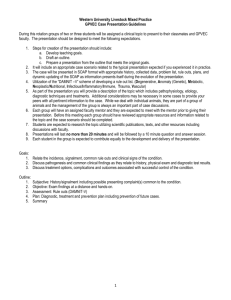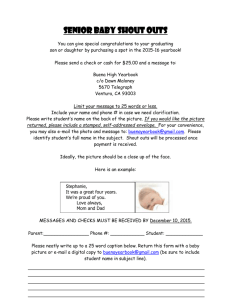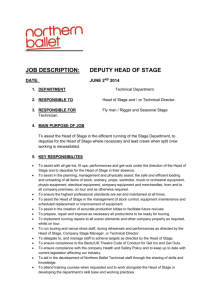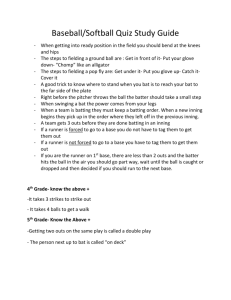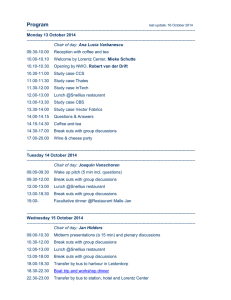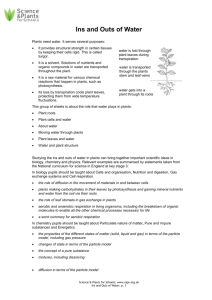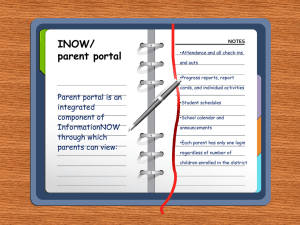Stock Outs in South Africa – A National Crisis
advertisement
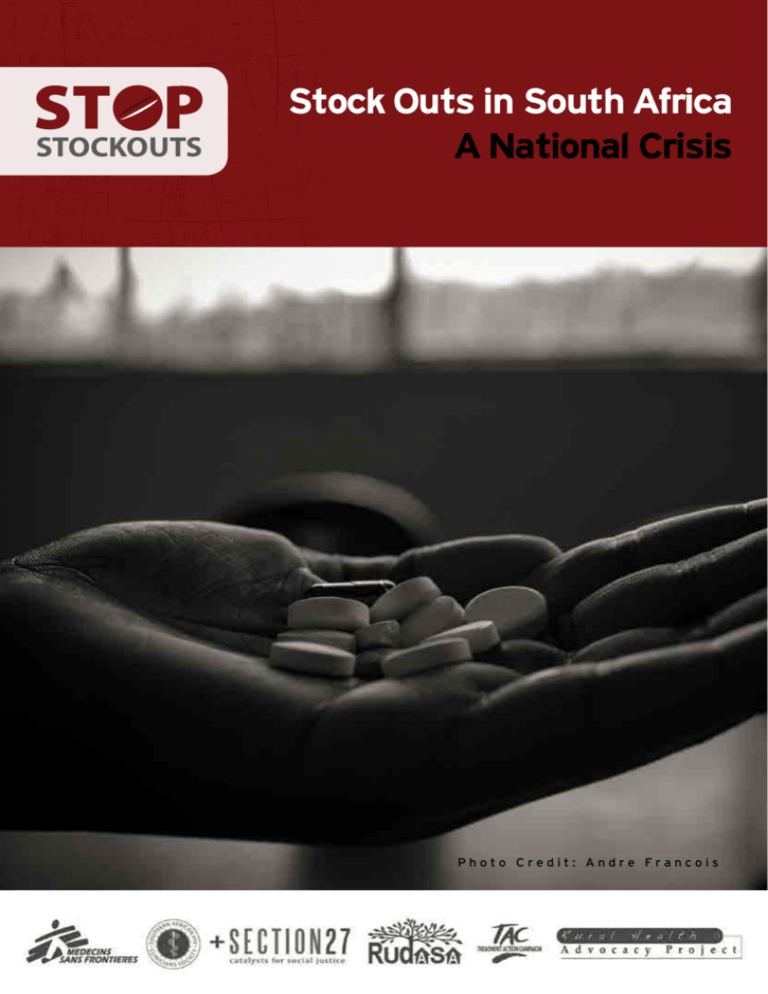
STOCKOUTS Stock Outs in South Africa – A National Crisis Photo Credit: Andre Francois SSP Stockouts National Survey – November 2013 Table of Contents Foreword page 1 Executive Summarypage 2 Stock Outs in South Africa: A National Crisis page 3 Methods: How we investigated the extent of stock outs in South Africa page 5 Results: ARV and TB medicine stock outs page 6 Results: Vaccine stock outs page 11 Analysis of Results and Discussion page 13 Provincial Breakdownpage 14 Strengths & Limitations page 17 Conclusionspage 18 Recommendationspage 19 Appendixespage 20 Photo Credit: Francesco Zizola 2 SSP Stockouts National Survey – November 2013 Foreword It is our people who suffer In recent years we have received many reports of clinics and hospitals running out of essential medicines. The impact of this on our people is severe. When we can’t take the medicines we need to control HIV or to cure tuberculosis, our health and the well-being of our communities are put at risk because we may develop resistance to those medicines. When clinics and hospitals run out of medicines it can be very bad for our health. It also burdens us with out of pocket costs we cannot afford. Many of us do not have much money and struggle to pay for transport to the clinic. Because of medicines stock outs we are often told to come back every two weeks instead of every month. This costs time and money only to reach the clinic and be told there are no medicines. This is unacceptable. These medicines stock outs at our clinics and hospitals are undermining South Africa’s fight against HIV, TB and other serious diseases. We cannot allow it to continue. What use is it to spend billions of Rands on medicines if we cannot get them to patients on time, allow them to expire at depots or to be stolen? So far, we have had some good cooperation from the National Department of Health in dealing with the crisis of medicines stock outs. Where provincial health systems have failed, the National Department has intervened to provide emergency stocks, but very often, the intervention only happened after we had made them aware of a clinic having a stock out. Unfortunately, until very recently the leadership in many provinces, particularly the Eastern Cape, were in denial about the stock outs plaguing our health system. They show little understanding of the urgency of the problem and have displayed no political will to take on the corruption, mismanagement and incompetence that contributes to these stock outs. These leaders must be held accountable for their incompetence and indifference. - Anele Yawa In this report we provide concrete evidence from a nationwide survey of medicines stock outs. The picture is bleak. Many more people are affected than what we had previously thought. This is a national emergency and must be treated as such. MECs for health can no longer say that they didn’t know. The evidence is here. Now they must act. - Anele Yawa, Chairperson, Treatment Action Campaign 1 SSP Stockouts National Survey – November 2013 Executive Summary With approximately 2.4 million people on antiretroviral therapy (ART) and more than 300,000 people treated for tuberculosis (TB) every year, South Africa has the largest HIV treatment programme in the world and an enormous associated TB treatment programme. Ensuring regular and uninterrupted supply of antiretroviral (ARVs) and TB medicines is critical for its success. Medicine stock outs are the Achilles heel that threatens programme quality and patients’ lives. The Stop Stock Outs Project (SSP) is an independent civil society consortium that monitors and speaks out about medicine stock outs and shortages, with the aim of achieving a stock out free health system. SSP grew following the Mthatha Depot Crisis intervention in the Eastern Cape in late 2012, where 53% of facilities served by the depot reported ARV and/or TB medicine stock outs and 24% of facilities had to send patients home without ARVs. To quantify the extent of ARV, TB and vaccine stock outs at the provincial and national level, the SSP undertook a national telephonic survey between September and October 2013. More than one in five facilities (459/2,139 - 21%) reported a stock out or shortage of ARV and/or TB medicines in the preceding three months, of which half (242/459 – 52.7%) were still facing shortages at the time of survey. Six out of the nine South African provinces had more than 17% of their facilities reporting shortages, with provincial percentages ranging from 53.9% in the Free State to 4.4% in North West. Facilities reported shortages of ARVs (403; 18.8%) more often than of TB medicines (68; 3.2%), with almost half of ARV stock outs being of lamivudine, efavirenz or stavudine. The median duration of shortages was 30 days, ranging from 1 day to 1 year. In 20% of affected facilities patients were sent home or referred elsewhere without medicines. This is the largest survey to date on the extent of stock outs and shortages in the South African antiretroviral treatment programme, with a sample size large enough to give an accurate national picture. In summary, the findings of the survey teach us the following critical lessons: • The extent of medicine shortages, especially of ARVs, in South Africa is enormous, far beyond previous estimations, and affects most provinces. 2 • The current passive monitoring system is not working. • Health staff at facility level acknowledge the problem when contacted and are eager to work to solve it. Medicine stock outs and shortages lead to patients taking partial doses of their treatment, interrupting it or defaulting treatment altogether. Medical consequences and costs to the health system and patients can be grave, including drug resistance, decreased immunity, increased risk of opportunistic infections and transmission of HIV and TB, ultimately leading to more illness and death. This is a crisis and needs to be handled as such. Under the Constitution, everyone is entitled to access to health care services (which includes essential medicines) and there is an obligation on the state to ensure access to such services and also to ensure that where services (or medicines) are available, they remain available. The first step is to assess and acknowledge the problem. To protect the health of people who depend on the public health system, the SSP calls upon national and provincial departments of health to urgently develop a plan with clear timelines to improve monitoring, prevention of, and response to stock outs. 2.4 Million Patients on HIV Treatment in South Africa SSP Stockouts National Survey – November 2013 Stock Outs in South Africa: A National Crisis I am living with HIV and am on ARVs. I also have tuberculosis and am receiving treatment for it. I use my clinic to collect my treatment and for any other medical issues that I may have. I have had difficulty getting my treatment since January 2013. In January, my clinic ran out of 3TC and I had to borrow pills from my neighbor. In February, my clinic ran out of Kaletra. They told me to come to the clinic each week to check for Kaletra and they began to give me a week’s supply at a time. I would check in at the clinic two days prior to when my supply would finish to ensure that they could provide medication for the next week. In March, they told me that I must go to another clinic for my treatment. I refused to go and conducted a sit in at my clinic. This was a way of making a point that I have a right to treatment and do not want to default yet the clinic was not providing what I needed. The nurses eventually offered me Kaletra meant for children, but I refused to accept it because it is not what I am supposed to take. I sat for almost the whole day until eventually a nurse went to another clinic and brought me the treatment. I then went home. In April, my clinic was again short of Kaletra and I was only given one bottle instead of the two I am supposed to receive each month. I returned to the clinic and collected a second bottle later in the month. The Kaletra has now run out. I do not have medication for tomorrow but have sent my sister to try to collect Kaletra from the clinic today. If she is not successful, I will not have any. I have not yet defaulted but it is extremely difficult to adhere to my treatment when [the] Clinic is constantly running out of stock. I have faced repeated and on-going barriers to accessing my medication. It is only through great personal effort that I have managed not to default up to this point.” - Patient, Eastern Cape, May 2013 1 in 5 420,000 Patients on antiretroviral medicine rely on those affected facilities 30 Days Average length of an ART stock out or shortage ha Reinders Photo Credit: Samant Facilities reporting an ARV and/or TB Stock Out or Shortage (459/2139) 3 SSP Stockouts National Survey – November 2013 Stock outs in South Africa – A national crisis continued... In December 2012 Médecins Sans Frontières /Doctors Without Borders (MSF) &Treatment Action Campaign (TAC) responded to the crisis by supporting staffing, management and medical supplies delivery at the depot. Findings were published in a report that was supported by a wider civil society consortium, the SSP, which also includes The Southern African HIV Clinician’s Society, SECTION27, Rural Health Advocacy Project (RHAP), and the Rural Doctors’ Association of Southern Africa (RUDASA).The report was designed to stimulate improvements to the medicines supply system in the Eastern Cape. Returning in May 2013 to evaluate progress, the consortium were both surprised and saddened to find that 40% of all facilities in the area continued to suffer stock outs of ARV and/or TB medicines. To understand why stock outs were still occurring in Mthatha and beyond, doctors, nurses and experts across the country were contacted. It was clear that stockouts were occurring in every province. This information was echoed by patient and clinician testimonies. My daughters were both coughing and were covered in sores all over their bodies and in their mouths. They were both prescribed Panado, Amoxicillin and other medication, that I do not remember the name of. The other medication that I do not know the name of was out of stock and they therefore wrote me a referral letter to another clinic. However, the other clinic did not have the medication either. I was told to go and buy the medication from a private pharmacy. I could not afford to do this because I did not have any money. I returned to my home. The next day, my fouryear-old daughter was worse. I decided to take her to the hospital. However, she died when we were on our way to the hospital. ” - Patient, Eastern Cape, May 2013 4 Specific instances of shortages and stock outs were brought to the attention of responsible provincial and national authorities so that they could take action. Although there had been some concern that nurses would be hesitant to speak, in the overwhelming majority of cases they were frustrated by the inaction and wanted to share their experiences as a means of stimulating change. Patients also appreciated having an outlet for their frustration and expressed fear about the consequences of the lack of availability of ARV and TB medicines on their own health. Because of this we can report now on stock outs in South Africa, a national crisis. I greatly respect what the minister has done, there has been a wonderful turn around in the system in general but stock outs remain a problem.” - Doctor working with HIV/TB patients, Limpopo Me ws Pho to Cre dit: And rew On 10 October 2012, staff at Mthatha depot in the Eastern Cape staged a strike, leaving the depot barely functioning on a skeleton staff. Coupled with chronic supply chain issues, this precipitated widespread regional medicine stock outs, with an estimated 53% of facilities served by the depot experiencing ARV and/or TB medicine stock outs and sending over 6,000 patients home with no ARVS. Mthatha Pharmaceutical Depot, January 2013 SSP Stockouts National Survey – November 2013 Methods: How we investigated the extent of stock outs in South Africa In order to establish the extent and effects of stock outs in South Africa, a telephone questionnaire survey was conducted during September and October 2013. Survey assistants were trained in the use of the script and standardised information was collected from all facilities contacted. For the purposes of the survey, a “stock out” is defined as physically having no stock (as identified by the health care worker responding) of a medicine which was required for patient use in that facility. A “stock shortage” was defined as having less stock of a medicine available in the facility than required for patients until the next order was received (as identified by the health care worker responding). Photo Credit: Gideon Mendel A list of facilities in South Africa was obtained from the national health information system. Upon calling a facility, the surveyor asked to speak to the head nurse/ matron or pharmacist. The motivations and aims of the survey were explained to each respondent and they were asked to respond anonymously to questions on stock outs in their facility. Where a facility was called but unreachable, up to four additional attempts were made. 5 SSP Stockouts National Survey – November 2013 Results Survey response The survey team made contact by telephone with 2,342 (61%) of the 3,826 identified facilities. In the remainder of cases a telephone number for that facility was not obtainable, or the number called was unreachable. Of the facilities that were contacted, 91% (2,139/2,342) provided information. In the other 9% (203) of cases the individual answering the phone declined to participate. This suggests health staff in facilities acknowledge the problem of stock outs and are willing to collaborate to solve it. Table 1: Facilities that were contactable and provided information on stock outs of ARV and/or TB medicines Province Number of facilities identified Number (%) of facilities contactable by phone Number (%) of facilities providing information Eastern Cape 703 468 (66.6%) 447 (95.5%) Free State 260 191 (73.5%) 167 (87.4%) Gauteng 410 316 (77.1%) 284 (89.9%) KwaZulu Natal 766 393 (51.3%) 332 (84.5%) Limpopo 374 228 (61.0%) 218 (95.6%) Mpumalanga 348 234 (67.2%) 224 (95.7%) Northern Cape 98 65 (66.3%) 62 (95.4%) North West 342 192 (56.1%) 182 (94.8%) Western Cape 525 255 (48.6%) 223 (87.5%) Total 3,826 2,342 (61.2%) 2,139 (91.3%) Reported Stock Outs in South Africa From the thousands of facilities phoned, a picture of widespread and long-lasting stock outs emerged. The most alarming finding was the magnitude of the problem, affecting at least one in every five health facilities, with 459 (21.4%) facilities reporting a stock out or shortage of ARV and/or TB medicines within the three months prior to being contacted. Over 420,000 patients on antiretroviral medicine rely upon those affected facilities for life saving medicine. 6 Over half of these stock outs had not been resolved: 52.7 % (242/459) were ongoing at the time when respondents answered survey questions, with over 220,000 patients on ART at these facilities. There was wide variation between provinces. Nationally, six out of nine provinces had stock outs in at least 17% of their facilities. The proportion of facilities reporting stock outs in each province ranged from 4.4% to 53.9%, with the Free State being the most severely affected province (Figure 1). SSP Stockouts National Survey – November 2013 Figure 1: Percentage of facilities reporting ARV and/or TB stock outs by province Free State 54% Limpopo 41% Mpumalanga 26% Gauteng 20% Eastern Cape 20% Northern Cape 18% KwaZulu Natal 14% Western Cape 5% North West 4% 0 10 20 30 40 50 Proportion of facilities that provided information which reported an ARV and/or TB medicine stock out or shortage in the 3 month period prior to being contacted. Information on the duration of ART and/or TB treatment stock outs was reported from 91.5 % (420 / 459) of responding facilities. ARV stock outs lasted on average for a month (median 30 days, interquartile range 14-60 days) with the stock outs of the longest duration being found in the Free State and Limpopo. For more information on stock out duration see Appendix IV. Stock outs were widely distributed, with many in urban areas, particularly in the eastern part of the country (figure 5). I am on Truvada and EFV. In June for 2 weeks, I went to the clinic for medication and we were sent back without anything. I had to buy drugs from a pharmacy for ZAR495. I am lucky at least I could buy them but I know there are many people who are not as privileged as I am and would not be able to raise money and buy the drugs.” - Patient, Gauteng, October 2013 “It is very frustrating as a doctor to try and provide care for your patients but you don’t have the tools, in this case the medication, to do so. Stock outs play a big role in destroying the trust and relationship between doctors and their patients.” - Doctor working with HIV/TB patients, Eastern Cape, October 2013 7 SSP Stockouts National Survey – November 2013 Results: ARV and TB medicine stock outs ARV and TB medicine stock outs 403 (18.8 %) facilities reported a problem with ARV supply and 68 (3.2%) with TB supply. Few facilities, 12 (2.6%) reported facing problems with both ARV and TB medicines. 22 different ARV and TB medicines were reported by health care workers as unavailable.1 403 facilities had problems with ARV treatment I am a patient at my clinic and have been on ARVs since 2005. I went to the clinic [earlier] this year and was given only two weeks supply and told to come back when finished. When I went back at the end of two weeks, I was told that the medicines were out of stock and I went for two weeks without treatment. At present, I have found out that my CD4 count has decreased from 1000 to 500. Five people from my support group have died in the past year ... I am scared of developing resistance.” - Patient, Eastern Cape, October 2013 68 facilities had problems with TB treatment 12 facilities had problems with both ARV and TB treatment Of the facilities that reported stock outs, 69 out of 459 (15.1%) reported more than one item, with 4 (0.8%) facilities reporting that they had no medicines for the treatment of HIV at all (for a more detailed breakdown of ARV and TB stock outs by province see appendices II, III & IV). 1 Tenofovir, Abacavir, Zidovudine, Lamivudine, Efavirenz, Stavudine, Nevirapine, Lopinavir/ritonavir, Ritonavir, Didanosine, Fixed Dose Combination, Tenofovir/emtricitabine, Lamivudine/zidovudine, Pyrazinamide, Isoniazid, Rifampicin, Ethambutol, RHZE, RH, Kanamycin, Steptomycin, Co-Trimoxazole &Vaccines 8 What medicines were most commonly out of stock? Almost half of all reported stock outs were of lamivudine, efavirenz and stavudine (Figure 2). These findings back up recent reports from clinicians on the ground of huge challenges in providing lamivudine and efavirenz to patients We’ve had a lamivudine stock out for five months and counting, also a tenofovir stock out for the last 4 months.” - Doctor working with HIV/TB Patients, KZN, October, 2013 SSP Stockouts National Survey – November 2013 Figure 2: Proportion of all reported stock outs / shortages by drug. Lamivudine 22.7% Efavirenz 18.5% Stavudine 17.0% (TEE) FDC 9.4% Tenofovir 6.2% Abacavir 4.8% Ritonavir/Lopinavir sol 3.9% 0 5 10 15 20 Photo Credit: Samantha Rein ders Percentages are number of facilities reporting stock out of a medicine over total number of reported stock outs. We asked facilities reporting stock outs to report on what happened to affected patients, with 82% (376/459) of respondents providing information. Most commonly, 36% (136/376), facilities reported borrowing medicines from other facilities to reduce the impact of stock outs. In 15% (57/376) of cases patients were given a shortened medicine supply. Not all patients can afford to come back regularly enough to maintain adherence, and may become ill and/or default treatment as a result. This will also lead to unnecessary expenses, placing an additional burden on low income families. I was stressed because I am unemployed and so I had borrowed money to come to the clinic. The situation was now forcing me to find a way of getting back to the clinic to get more drugs. I struggle to make ends meet and sometimes I take the drugs on an empty stomach because I do not have food. “ - Patient, Eastern Cape, October 2013 In 61 facilities patients were changed to another medicine that was available at the facility. In 47 cases patients were given a different strength of the out of stock medicine, increasing the daily pill burden in order to take the correct dose needed. Taken together this means in 29% (108/376) of cases regimen/dose changes were carried out. It should be noted that not all such switches would be harmful to patients (e.g. stavudine switched to fixed dose combination). 9 SSP Stockouts National Survey – November 2013 Results: ARV and TB medicine stock outs Most alarmingly, in 20% of cases patients were sent home with no medication or referred elsewhere, leaving the facility without medication. These are the patients most at risk of suffering severely from stock outs. I am a patient at my clinic. I have been on ARVs since 2010... Since 9 October I have not been able to get EFV from the clinic so I am only taking the other two drugs. I was told there is nothing wrong with only taking the two medications alone without the EFV. On 14 October I went back to the clinic to check if they now had some and they said they still do not have. I am scared but there is nothing I can do.“ Photo Credit: Samantha Rein ders - Patient, Limpopo, October, 2013 10 Stavudine Stavudine stock levels have been significantly scaled down in South africa. There is still a need for some stock as this ARV is necessary for a small sub-set of patients. Planning and communication to health care workers regarding the scale down of stavudine for the majority of patients has been unclear, resulting in many facilities experiencing and reporting stock outs or shortages. If stavudine is excluded from calculating the national picture, a similar proportion, 17.3% of facilities nationwide experienced a stock out or shortage of ARV and/or TB medicines. If stavudine is included this number increases to 21.4%. SSP Stockouts National Survey – November 2013 Figure 3: Reported impact of medicine stock outs upon patients. 20% Sent Home with No Medicine or Referred Away from Facility with No Medicine Changed dose/ Regimen Shortened supply given 20% 15% 36% 15% Borrowed meds 29% 29% 36% Results from facilities that reported stock outs of ARV and/or TB medicines in the 3 months preceding the survey. Of the 459 facilities reporting medicine stock outs, in 86 cases facilities were unable to or declined to provide information relating to the patient consequences of that stock out. These respondents have been removed from the denominator. Vaccines Although the survey focussed on ARV and TB medicines, there are supply challenges with other essential medical commodities in South Africa. As an indicator for other essential products in outreach to facilities nationwide, we also inquired about availability of vaccines. Reports of stock outs of vaccines were less severe than for ARV and TB medicines, but widespread nonetheless, and could contribute to avoidable disease, particularly in children. I went to the clinic in mid-April to have my two year old child vaccinated against polio. The vaccination was not available and the nurses told me to come back... they told me once again that the immunization was unavailable and once again asked me to return.“ - Patient, Eastern Cape, May 2013 11 SSP Stockouts National Survey – November 2013 Results: Vaccine stock outs 2047 facilities responded regarding vaccines. Of those responding 14.7% (301) of facilities nationally reported a vaccine stock out or shortage in the previous three months. We found that some provinces were much more severely affected than others, with up to 1 in 3 facilities experiencing recent vaccine stock outs in the worst cases. These results mirrored findings regarding ARV and TB medicines (Figure 4). Figure 4: Number and proportion of facilities in South Africa that were contactable, and provided information in relation to telephone survey on facility level experience of stock outs of vaccines in the 3 preceding months. Limpopo 35.6% Free State 32.2% Mpumalanga 15.5% Eastern Cape 12.5% Northern Cape 11.7% North West 9.9% Western Cape 9.5% Guateng 8.5% KwaZulu Natal 6.2% 0 5 Stock outs and the law: the legal framework. Under the Constitution, everyone is entitled to access to health care services (which includes essential medicines). There is an obligation on the State to ensure access to such services and also guarantee that where services (or medicines) are available, they remain available. The State is also constitutionally obliged to respect, protect, promote and fulfil the rights to life and to dignity and to ensure efficient use of resources to respond to people’s needs. The National Health Act 61 of 2003 places obligations on the Minister of Health and MECs and Heads of Department in each province. These role players are required to create policy (the Minister and MECs), implement that policy in the provinces (MECs), and to plan for the provision of services and facilities and the quality of such services and facilities (HoDs). 12 10 15 20 25 30 35 The Pharmacy Act and Rules govern both facility pharmacies and medicines depots. They place obligations on the Responsible Pharmacist at a pharmacy or depot to ensure that stock levels are adequate to maintain accessibility of medicines and that stock control systems are in place. These and other sources of law place obligations on the Minister, MECs, Heads of Departments, Depot Responsible Pharmacists, and facility Responsible Pharmacists. These obligations are legally enforceable, meaning that the office holders can be sued in their official capacities if they fail to comply with their obligations. While it is not always clear where the problem in the supply of medicines to patients arises, it is clear that there is an enforceable obligation on the state to ensure the availability of medicines. SSP Stockouts National Survey – November 2013 Analysis of Results & Discussion This survey highlights a crisis in South Africa’s antiretroviral programme. Lack of access to medicines has complex underlying causes, ranging from health programme implementation to medicine supply chain systems. These involve facility, municipal, district, provincial and national actors. It is very difficult to pin point what the exact problem is since there is no trend when it comes to stock outs. One clinic will be out of stock of an item but the other clinics have it? Sometimes the depot is out of stock of an item.“ - Doctor working with HIV/TB patients, Eastern Cape, October 2013 1 in every 5 facilities contacted had a stock out in the three months preceding the survey; over a year this would likely be even higher. Of the hundreds of thousands of patients who need medicine from those facilities in order to live healthily, many tens of thousands are forced, through no fault of their own, to go without. I go to the clinic every month. Every month there is a shortage of lamivudine and they say you have to come back next week. Sometimes they have some other medicines and sometimes they don’t. It’s not their fault. It’s the department. [It last happened] in September. It happens every month that if you are at the end of the queue you don’t get all your medicine.“ Many patients will be at risk of developing and transmitting drug resistance, interrupting and even defaulting treatment, and ultimately at increased risk of illness and death. While South Africa has made great strides to extend access to ART as well as increase the quality of the services it provides patients, the millions of rand invested are meaningless to the patient who walks away from a clinic without the medicine in his or her hand. The stock outs are also demoralising to health care workers. Being forced to turn away a patient because no treatment is available goes against the core of a health care worker’s job. Deciding who does and who doesn’t get treatment, and how much everyone can get, is equally unbearable. Often patients are given a small supply and asked to come back to the clinic but most patients can’t afford to do this or live too far from the clinic to be able to return often. “ - Doctor working with HIV/TB patients, Eastern Cape, October 2013 - Patient, Mpumalanga, October 2013 13 SSP Stockouts National Survey – November 2013 14 SSP Stockouts National Survey – November 2013 15 SSP Stockouts National Survey – November 2013 Analysis of Results & Discussion continued... It is necessary to better understand what the underlying causes are. The survey does not identify the causes of the reported stock outs nor is it able to pinpoint shortcomings and failures in the supply chain. Nevertheless, through our work in Mthatha, by speaking to depot managers, clinicians and patients all across the country, some fundamental weaknesses in the system are evident. Pho to Cred it: And re Fran cois Stock out and medication shortages are underreported; passive monitoring, where we wait for staff to report stock outs, is failing. There is a need for an active monitoring system to be set up, one with active, systematic screening for shortages and stock 16 outs. This needs to communicate to a rapid response team, ready to intervene to prevent and/or resolve stock outs without delay. Poor visibility of stock outs leads to lack of accountability and delayed responses. There is a lack of systematic follow up of orders and a delayed response to supply side errors. A number of health professionals reported that primary health care staff often lack adequate training to manage medication supply. Staff at facility level also need to be trained on strategies to ensure minimal harm to patients if a stock item is not available. SSP Stockouts National Survey – November 2013 Strengths & limitations of survey We succeeded in contacting 2,139 (61%) of all facilities identified in South Africa, of which almost all (91%) agreed to take part. The high response rate among those contacted is important because it reduces bias that may arise from differences in the characteristics of facilities that declined to take part. Often in surveys of healthcare staff, individuals wish to create a favourable impression of where they work. If this occurred in our survey it would lead to an underestimation of the true extent of the problem. would be unaware of whether or not a stock out had recently occurred in that facility, what medicine was affected and whether there was still a stock out at the time the call was made. If some of the interviewees were not aware of a stock out, this would lead us to underestimate the overall extent of stock outs in Nurses are reluctant to report on things that will reflect poorly on them. “ - Doctor working with HIV/TB patients, Eastern Cape, October 2013 South Africa. Finally, as individual recall of when the stock out began and when it was resolved are likely to be more prone to error, the estimated duration of stock outs participation from facilities that were contactable means that our results should paint an accurate picture of what is happening nationally. That is to say that the findings should apply not just to the 61% of facilities that we contacted but more broadly to all facilities in South Africa. Photo Credit: Samantha Rein Overall, the sample size was large. The high ders should be seen as indicative rather than exact. A potential constraint of the survey could be the limited knowledge of respondents, who can only report on stock outs they are aware of. However, since in most cases, pharmacists or senior nurses were contacted, it is unlikely that respondents 17 SSP Stockouts National Survey – November 2013 Conclusions While many positive changes to the National HIV/AIDS & TB programme in South Africa have occurred in recent years, with increased access to care, improved leadership and a real desire to address historical inequalities in the health system, obstacles to sustain these achievements have arisen. With over two million people now on treatment and many more still to be initiated, the constraints facing the maintenance of a functioning HIV programme will only increase. Supply management is, and will be, one of the key limitations to any quality HIV/AIDS programme. The fact that around one in five facilities reported a stock out of ARVs or TB medication within the preceding three months is startling and represents a crisis requiring urgent action. These supply limitations are also occurring in the context of a renewed focus on the improvement of the health system as part of the National Health Insurance policy and of the National Strategic Plan on HIV, TB and STIs, which also includes the target of over three million people on ARV treatment by 2016. If these initiatives are to be successful, ongoing supply problems must be tackled. It is important to note that medication stock outs and shortages are also a violation of the Constitutional rights of patients and a breach of the obligations of the Department of Health. Talk of “stock outs” and statistics can be misleading. The actual and true consequence of a collapse of the supply system is human loss, as detailed by the testimonies of patients quoted throughout this document. It cannot 18 be forgotten that treatment interruptions can lead to unnecessary suffering, costly resistance and, in the worst cases, death. It is therefore hoped that this report is regarded as the start of a constructive dialogue between civil society, patients and the Department of Health. Recognising and identifying problems in healthcare delivery is the first step to finding solutions and, in turn, improving quality of care. Empowering patients to claim their rights, demand the care they deserve and to hold all levels of the system accountable is also a necessary step in improving service delivery and health results for all South Africans. Photo Credit: Borrie Lagrange Stories of medical supply shortages have been prevalent and observed throughout facilities nationwide for many years, but this report has been the first attempt to fully quantify and qualify the real scale of the problem. It is hoped that this is just the first step in the journey to monitor, respond and eliminate stock problems across South Africa’s healthcare system. SSP Stockouts National Survey – November 2013 Recommendations At the national and provincial level: A concrete high level strategy, with clear timelines, is needed to address the issue of stock outs in South Africa. This strategy should be drawn up with provincial input and we ask that civil society and patients are included in its drafting. We believe that this strategy should address, but not be limited to, the following: • How permanent active stock out monitoring capacity can be created provincially and nationally • A clear process for the rapid response to identified stock outs • How longstanding issues related to stock forecasting, monitoring and distribution can be fixed • A mechanism to ensure provincial and national accountability for timely resolution • The inclusion of patients on governance boards throughout all levels of the health service facing patients. The main goal of the SSP is to bring awareness to stock outs as they occur and highlight problem areas in the supply chain that need attention. Follow up of Ongoing Stock Outs: Of the ongoing stock outs facilities reported in this survey, to date, the SSP has: • Responded to 150 cases of ongoing stock outs o 86 cases of stock outs were resolved by the facility o 64 stock out case files were handed to the SSP o 7 closed (resolved) cases Stop Stock Outs Project: Civil society has an important role to play in bringing stock outs to an end The project aims to empower the tens of thousands of patients and clinicians affected by stock outs. The Stop Stock Outs Project (SSP) is civil society’s response to bring transparency to medicine supply problems o 57 open (ongoing) cases (FS = 17, LP = 16, KZN = 12, EC = 7, GP = 3, NW = 1, NC = 1) escalated to the National Department of Health for further investigation To report a stock out to the SSP, send a SMS or Please Call Me to 084 855 7867 (STOP) or email report@stockouts.co.za 19 SSP Stockouts National Survey – November 2013 Appendix I: Figure 6: Source of supply for those facilities which reported stock outs of ARV/TB medicines 51% 32% 11% 4% Depot Hospital Sub-depot Other 0.30% Direct Supply Of the 459 facilities that report experiencing stock outs or shortages of ARV and / or TB medicines in the months prior to being contacted, 381 were able to estimate the start and finish data of the stock out. Where a stock out was ongoing the median was calculated using the day of the survey as the finish date so the numbers shown here will underestimate the median duration of stock outs. Appendix II: District level information of stock outs of ARV and / or TB medicines. Facilities in the Eastern Cape that reported stock outs or shortages of ART and/or TB treatment by District in the 3 months prior to being phoned District Number of facilities that reported ART and /or TB stock outs in the district(n) Total number of facilities that were contactable in each district( c) Total number of facilities in each District that agreed to answer survey questions (N) Percentage (%) Of facilities that reported ART and/or TB stock outs in each district (n/N*100) A Nzo 22 60 57 38.6 Amathole 4 87 87 4.6 Buffalo City 6 56 52 11.5 Chris Hani 21 109 106 19.8 Cacadu 4 29 25 16 Joe Gqabi 9 23 23 39.1 Nelson Mandela Bay 5 39 34 14.7 OR Tambo 18 65 63 28.6 Total 89 468 447 19.9 Out of the 447 facilities that responded to queries in the Eastern Cape, 89 (19.9 %) reported ART and/or TB medicine stock outs or shortages in the 3 months prior to the survey. 20 SSP Stockouts National Survey – November 2013 Table showing the number of facilities in the Free State that reported stock outs or shortages of ART and/or TB treatment by District in the preceding 3 months of being phoned District Number of facilities that reported ART and /or TB stockouts in the district(n) Total number of clinics that were contactable in each district( c) Total number of facilities in each District that agreed to answer survey questions (N) Percentage (%) Of facilities that reported ART and/or TB stock outs in each district (n/N*100) Fezile Dabi 18 28 27 66.7 Lejweleputswa 14 37 34 41.2 Mangaung 19 39 34 55.9 T Mofutsanyane 35 72 57 61.4 Xhariep 4 15 15 26.7 Total 90 191 167 53.9 Out of the 167 facilities that responded to queries in the Free State, 90 (53.9%) reported ART and/or TB medicine stock outs or shortages in the 3 months prior to the survey. Appendix II (continued): District level information of stock outs of ARV and / or TB medicines Facilities in Gauteng Province that reported stock outs or shortages of ART and/or TB treatment by District in the preceding 3 months prior to survey District Number of facilities that reported ART and /or TB stock outs in the district(n) Total number of facilities that were contactable in each district( c) Total number of facilities in each District that agreed to answer survey questions (N) Percentage (%) Of facilities that reported ART and/or TB stock outs in each district (n/N*100) Ekurhuleni 16 85 64 25 Johannesburg 22 102 96 22.9 Sedibeng 2 32 32 6.25 Tshwane 12 61 57 21.1 West Rand 6 36 35 17.1 Total 58 316 284 20.4 Out of the 284 facilities that responded to queries in Gauteng, 58 (20.4 %) reported ART and/or TB medicine stock outs or shortages in the 3 months prior to the survey. 21 SSP Stockouts National Survey – November 2013 Facilities in KwaZulu Natal that reported stock outs or shortages of ART and/or TB treatment by District in the preceding 3 months prior to survey District Number of facilities that reported ART and /or TB stock outs in the district(n) Total number of facilities that were contactable in each district( c) Total number of facilities in each District that agreed to answer survey questions (N) Percentage (%) Of facilities that reported ART and/or TB stock outs in each district (n/N*100) Amajuba 10 20 19 52.6 Sisonke 1 18 17 5.9 Ugu 5 36 33 15.2 Umkhanyakude 4 26 21 19.1 Umzinyathi 1 34 27 3.7 Uthukela 2 27 21 9.5 Uthungulu 9 51 41 21.9 Zululand 4 44 37 10.8 eThekwini 1 67 60 1.7 iLembe 4 30 28 14.3 uMgungundlovu 4 40 28 14.3 Total 45 393 332 13.6 Out of the 332 facilities that responded to queries in KwaZulu Natal, 45 (13.6 %) reported ART and/or TB medicine stock outs or shortages in the 3 months prior to the survey Appendix II (continued): District level information of stock outs of ARV and / or TB medicines. Facilities in Limpopo Province that reported stock outs or shortages of ART and/or TB treatment by District in the preceding 3 months prior to survey District Number of facilities that reported ART and /or TB stock outs in the district(n) Total number of facilities that were contactable in each district( c) Total number of facilities in each District that agreed to answer survey questions (N) Percentage (%) Of facilities that reported ART and/or TB stock outs in each district (n/N*100) Capricorn 28 69 68 41.2 Gr. Sekhukhune 25 58 55 45.5 Mopani 11 30 28 39.3 Vhembe 16 48 45 35.6 Waterberg 9 23 22 40.9 Total 89 228 218 40.8 Out of the 218 facilities that responded to queries in Limpopo Province, 89 (40.8 %) reported ART and/or TB medicine stock outs or shortages in the 3 months prior to the survey 22 SSP Stockouts National Survey – November 2013 Facilities in Mpumalanga that reported stock outs or shortages of ART and/or TB treatment by District in the 3 months prior to survey District Number of facilities that reported ART and /or TB stock outs in the district(n) Total number of facilities that were contactable in each district( c) Total number of facilities in each District that agreed to answer survey questions (N) Percentage (%) Of facilities that reported ART and/or TB stock outs in each district (n/N*100) Ehlanzeni 29 108 103 28.2 G Sibande 5 34 33 15.2 Nkangala 24 92 88 27.3 Total 58 234 224 25.9 Out of the 224 facilities that responded to queries in Mpumalanga, 58 (25.9 %) reported ART and/or TB medicine stock outs or shortages in the 3 months prior to the survey. Facilities in the Northern Cape that reported stock outs or shortages of ART and/or TB treatment by District in the preceding 3 months of being phoned District Number of facilities that reported ART and /or TB stock outs in the district(n) Total number of facilities that were contactable in each district( c) Total number of facilities in each District that agreed to answer survey questions (N) Percentage (%) Of facilities that reported ART and/or TB stock outs in each district (n/N*100) J T Gaetsewe 0 2 2 0 Namaqua 1 23 22 4.5 Pixley Ka Seme 8 16 15 53.3 Siyanda 2 24 23 8.7 Total 11 65 62 17.7 Out of the 62 facilities that responded to queries in the Northern Cape, 11 (17.7 %) reported ART and/or TB medicine stock outs or shortages in the 3 months prior to the survey. 23 SSP Stockouts National Survey – November 2013 Facilities in the North West that reported stock outs or shortages of ART and/or TB treatment by District in the 3 months prior to survey District Number of facilities that reported ART and/ or TB stock outs in district (n) Total number of clinics Total Number of Percentage (%) that were contactable responding facilities in Of facilities that in each district( c) District (N) reported ART and/or TB stock outs in each district (n/N*100) Bojanala Platinum 6 56 49 12.2 Dr K Kaunda 0 30 30 0 Ngaka Modiri 2 73 70 2.9 Ruth Segomotsi 0 33 33 0 Total 8 192 182 4.4 Out of the 182 facilities that responded to queries in the North Western Province, 8 (4.4 %) reported ART and/ or TB medicine stock outs or shortages in the 3 months prior to the survey. Table showing the number of facilities in the Western Cape that reported stock outs or shortages of ART and/or TB treatment by District in the preceding 3 months of being phoned District Number of facilities that reported ART and/ or TB stock outs in district (n) Total number of clinics Total Number of Percentage (%) that were contactable responding facilities in Of facilities that in each district( c) District (N) reported ART and/or TB stock outs in each district (n/N*100) Cape Town 6 81 71 8.5 Cape Winelands 1 56 53 1.9 Central Karoo 1 16 16 6.3 Eden 3 51 41 7.3 Overberg 0 20 17 0 West Coast 0 31 25 0 Total 11 255 223 4.9 Out of the 223 facilities that responded to our queries in the Western Cape, 11 (4.9 %) reported ART and/or TB medicine stock outs or shortages in the 3 months prior to the survey. 24 SSP Stockouts National Survey – November 2013 Appendix III: District level information of stock outs of ARV medicines. The proportion of facilities reporting ART stock outs in the previous 3 months in the Eastern Cape District Number of facilities that reported ART and/ or TB stock outs in district (n) Total Number of responding facilities in District (N) Percentage (%) Of facilities that reported ART and/or TB stock outs in each district (n/N*100) A Nzo 21 57 36.8 Amathole 2 87 2.3 Buffalo City 5 52 9.6 Chris Hani 18 106 17 Cacadu 3 25 12 Joe Gqabi 8 23 34.8 Nelson Mandela Bay 4 34 11.8 OR Tambo 13 63 20.6 Total 74 447 16.6 The proportion of facilities reporting ART stock outs in the previous 3 months in the Free State District Number of facilities that reported ART and/ or TB stock outs in district (n) Total Number of responding facilities in District (N) Percentage (%) Of facilities that reported ART and/or TB stock outs in each district (n/N*100) Fezile Dabi 18 27 66.7 Lejweleputswa 13 34 38.2 Mangaung 17 34 50 T Mofutsanyane 33 57 57.9 Xhariep 4 15 26.7 Total 85 167 50.9 The proportion of facilities reporting ART stock outs in the previous 3 months in Gauteng Province District Number of facilities that reported ART and/ or TB stock outs in district (n) Total Number of responding facilities in District (N) Percentage (%) Of facilities that reported ART and/or TB stock outs in each district (n/N*100) Ekurhuleni 13 64 20.3 Johannesburg 21 96 21.9 Sedibeng 2 32 6.25 Tshwane 9 57 15.8 West Rand 5 35 14.3 Total 50 284 17.6 25 SSP Stockouts National Survey – November 2013 The proportion of facilities reporting ART stock outs in the previous 3 months in Gauteng Province District Number of facilities that reported ART and/ or TB stock outs in district (n) Total number of clinics Total Number of Percentage (%) that were contactable responding facilities in Of facilities that in each district( c) District (N) reported ART and/or TB stock outs in each district (n/N*100) Ekurhuleni 13 64 20.3 8.5 Johannesburg 21 96 21.9 1.9 Sedibeng 2 32 6.25 6.3 Tshwane 9 57 15.8 7.3 West Rand 5 35 14.3 0 Total 50 284 17.6 0 Appendix III (continued): District level information of stock outs of ARV medicines. The proportion of facilities reporting ART stock outs or shortages in the previous 3 months in KwaZulu Natal District Number of facilities that reported ART and/ or TB stock outs in district (n) Total Number of responding facilities in District (N) Percentage (%) Of facilities that reported ART and/or TB stock outs in each district (n/N*100) Amajuba 10 19 52.6 Sisonke 1 17 5.9 Ugu 5 33 15.2 Umkhanyakude 4 21 19.1 Umzinyathi 1 27 3.7 Uthukela 2 21 9.5 Uthungulu 7 41 19.5 Zululand 4 37 13.5 eThekwini 0 60 1.7 iLembe 4 28 14.3 uMgungundlovu 4 28 14.3 Total 42 332 12.7 26 SSP Stockouts National Survey – November 2013 The table below shows the proportion of facilities reporting ART stock outs in the previous 3 months in Limpopo District Number of facilities that reported ART and/ or TB stock outs in district (n) Total Number of responding facilities in District (N) Percentage (%) Of facilities that reported ART and/or TB stock outs in each district (n/N*100) Capricorn 23 67 34.3 Gr. Sekhukhune 22 55 40 Mopani 11 28 39.3 Vhembe 16 45 35.6 Waterberg 8 22 36.4 Total 80 218 36.7 The proportion of facilities reporting ART stock outs in the previous 3 months in Mpumalanga District Number of facilities that reported ART and/ or TB stock outs in district (n) Total Number of responding facilities in District (N) Percentage (%) Of facilities that reported ART and/or TB stock outs in each district (n/N*100) Ehlanzeni 28 103 27.2 G Sibande 5 33 15.2 Nkangala 23 88 26.1 Total 56 222 25.2 Appendix III (continued): District level information of stock outs of ARV medicines. The proportion of facilities reporting ART stock outs in the previous 3 months in the Northern Cape District Number of facilities that reported ART and/ or TB stock outs in district (n) Total Number of responding facilities in District (N) Percentage (%) Of facilities that reported ART and/or TB stock outs in each district (n/N*100) J T Gaetsewe 0 2 0 Namaqua 1 22 4.5 Pixley Ka Seme 6 15 40 Siyanda 2 23 8.7 Total 9 62 14.5 27 SSP Stockouts National Survey – November 2013 The table below shows the proportion of facilities reporting ART stock outs in the previous 3 months in North West District Number of facilities that reported ART and/ or TB stock outs in district (n) Total Number of responding facilities in District (N) Percentage (%) Of facilities that reported ART and/or TB stock outs in each district (n/N*100) Bojanala Platinum 5 49 10.2 Dr K Kaunda 0 30 0 Ngaka Modiri 2 70 2.9 Ruth Segomotsi 0 33 0 Total 7 182 3.8 The table below shows the proportion of facilities reporting ART stock outs in the previous 3 months in Western Cape District Number of facilities that reported ART and/ or TB stock outs in district (n) Total Number of responding facilities in District (N) Percentage (%) Of facilities that reported ART and/or TB stock outs in each district (n/N*100) Cape Town 2 73 2.7 Cape Winelands 1 53 1.9 Central Karoo 1 16 6.3 Eden 2 41 7.3 Overberg 0 17 0 West Coast 0 25 0 Total 6 223 2.7 Appendix IV: District level information of stock outs of TB medicines. The proportion of facilities reporting TB stock outs in the preceding 3 months in the Eastern Cape District Number of facilities that reported ART and/ or TB stock outs in district (n) Total Number of responding facilities in District (N) Percentage % of facilities reporting TB drug stock outs per district in the last 3 months (n/N *100) A Nzo 1 57 1.8 Amathole 2 87 2.3 Buffalo City 1 52 1.9 Chris Hani 3 106 2.8 Cacadu 1 25 3.8 Joe Gqabi 2 23 8.7 Nelson Mandela Bay 1 34 2.9 28 SSP Stockouts National Survey – November 2013 OR Tambo 7 63 11.1 Total 18 447 4.0 The proportion of facilities reporting TB stock outs in the preceding 3 months in the Free State District Number of facilities that reported ART and/ or TB stock outs in district (n) Total Number of responding facilities in District (N) Percentage % of facilities reporting TB drug stock outs per district in the last 3 months (n/N *100) Fezile Dabi 0 27 0 Lejweleputswa 2 34 5.9 Mangaung 3 34 8.8 T Mofutsanyane 3 57 7 Xhariep 0 15 0 Total 8 167 4.8 The table below shows the proportion of facilities reporting TB stock outs in the preceding 3 months in the Gauteng Province District Number of facilities that reported ART and/ or TB stock outs in district (n) Total Number of responding facilities in District (N) Percentage % of facilities reporting TB drug stock outs per district in the last 3 months (n/N *100) Ekurhuleni 3 65 4.6 Johannesburg 0 96 0 Sedibeng 0 32 0 Tshwane 3 57 5.3 West Rand 0 36 0 Total 6 284 2.1 29 SSP Stockouts National Survey – November 2013 Appendix IV continued: District level information of stock outs of TB medicines. The proportion of facilities reporting TB stock outs in the preceding 3 months in KwaZulu Natal District Number of facilities that reported ART and/ or TB stock outs in district (n) Total Number of responding facilities in District (N) Percentage % of facilities reporting TB drug stock outs per district in the last 3 months (n/N *100) Amajuba 1 19 5.3 Sisonke 0 17 0 Ugu 0 33 0 Umkhanyakude 1 21 4.8 Umzinyathi 0 27 0 Uthukela 0 21 0 Uthungulu 2 41 17.1 Zululand 0 37 0 eThekwini 1 60 1.7 iLembe 0 28 0 uMgungundlovu 0 28 0 Total 5 332 1.5 The table below shows the proportion of facilities reporting TB stock outs in the preceding 3 months in Limpopo District Number of facilities that reported ART and/ or TB stock outs in district (n) Total Number of responding facilities in District (N) Percentage % of facilities reporting TB drug stock outs per district in the last 3 months (n/N *100) Capricorn 7 67 10.4 Gr. Sekhukhune 3 55 5.5 Mopani 0 28 0 Vhembe 0 45 0 Waterberg 1 22 4.5 Total 11 218 5.0 30 SSP Stockouts National Survey – November 2013 The proportion of facilities reporting TB stock outs in the preceding 3 months in Mpumalanga District Number of facilities that reported ART and/ or TB stock outs in district (n) Total Number of responding facilities in District (N) Percentage % of facilities reporting TB drug stock outs per district in the last 3 months (n/N *100) Ehlanzeni 1 103 0.97 G Sibande 0 33 0 Nkangala 2 88 2.3 Total 3 224 1.3 Appendix IV continued: District level information of stock outs of TB medicines. The proportion of facilities reporting TB stock outs in the preceding 3 months in the Northern Cape District Number of facilities that reported ART and/ or TB stock outs in district (n) Total Number of responding facilities in District (N) Percentage % of facilities reporting TB drug stock outs per district in the last 3 months (n/N *100) J T Gaetsewe 0 2 0 Namaqua 0 22 0 Pixley Ka Seme 2 15 13.3 Siyanda 1 23 4.3 Total 3 62 4.8 The proportion of facilities reporting TB stock outs in the preceding 3 months in North West Province District Number of facilities that reported ART and/ or TB stock outs in district (n) Total Number of responding facilities in District (N) Percentage % of facilities reporting TB drug stock outs per district in the last 3 months (n/N *100) Bojanala Platinum 1 49 2 Dr K Kaunda 0 30 0 Ngaka Modiri 0 70 0 Ruth Segomotsi 0 33 0 Total 1 182 0.5 31 SSP Stockouts National Survey – November 2013 The proportion of facilities reporting TB stock outs in the preceding 3 months in North West Province District Number of facilities that reported ART and/ or TB stock outs in district (n) Total Number of responding facilities in District (N) Percentage % of facilities reporting TB drug stock outs per district in the last 3 months (n/N *100) Bojanala Platinum 1 49 2 Dr K Kaunda 0 30 0 Ngaka Modiri 0 70 0 Ruth Segomotsi 0 33 0 Total 1 182 0.5 The table below shows the proportion of facilities reporting TB stock outs in Western Cape District Number of facilities that reported ART and/ or TB stock outs in district (n) Total Number of responding facilities in District (N) Percentage % of facilities reporting TB drug stock outs per district in the last 3 months (n/N *100) Cape Town 4 71 5.6 Cape Wine lands 0 53 0 Central Karoo 0 16 0 Eden 1 41 2.4 Overberg - 17 - West Coast - 25 - Total 5 223 2.2 32 SSP Stockouts National Survey – November 2013 Appendix IV: Duration of reported stock outs Figure 7: Median duration of stock outs in days, by province, for facilities which reported a stock out of an ARV and/or TB medicines in the 3 months prior to being contacted for survey 54.5 38 37.5 30 30 30 30 30 pe Ca e n at Ea st er St ee Fr Ga ut en g N KZ po m Li n er No r th po pe Ca ga an al M pu m te es W No r th W rn es t Ca pe 20 Median duration of reported stock outs in days, for facilities that reported ARV and/or TB medicine stock outs in the 3 months prior to being contacted for survey Province Median duration in Days (inter-quartile-range) Reporting stock out duration North West 54.5 (7 – 107) 10 Western Cape 38 (22 – 53) 11 Mpumalanga 37.5 (15 – 60) 42 Northern Cape 30 (14 – 71) 11 Limpopo 30 (14 – 60) 85 30 (14 – 45.5) 40 Gauteng 30 (30 – 60) 55 Free State 30 (14 – 60) 86 Eastern Cape 20 (14 – 46) 84 National Median 30 (14 – 60) 424 KwaZulu Natal 33
